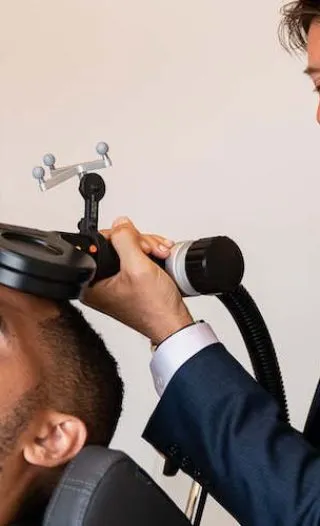A Painless and Non-Invasive Procedure
Transcranial magnetic stimulation therapy (TMS) is an FDA-approved treatment that involves passing gentle magnetic pulses through the scalp to stimulate certain brain cells. Research has shown it can improve mood and behavior in patients with clinical depression, anxiety disorders, addiction, and several other conditions – even those that have been resistant to other treatment methods.
While you may feel nervous trying something new, you can rest assured that TMS is painless, non-invasive, and takes up little time. Here is some more information about what to expect from TMS to help you make an informed decision about whether TMS is for you and prepare you for your treatment session.


TMS is a non-invasive procedure, meaning the therapist will not pierce your skin. You are completely conscious for the entire session and can interact with the therapist at all times. TMS only affects specific areas of the brain, leaving most of your cognitive and behavioral functions operating as normal, so you can comfortably drive to and from each session.
TMS is also painless, and your therapist works with you to make the session as comfortable as possible. Most patients describe TMS as a vibrating or tapping sensation. Your therapist can adjust the intensity of the machine to ensure that you are comfortable with the experience.
Read more: Success rate of TMS Therapy
Because TMS stimulates some brain cells that affect movement in your feet and hands, they may twitch during the treatment session. This is completely normal and nothing to be worried about. If you do feel uneasy, however, you can communicate this to your therapist at any time during the session.

During your TMS session, you are free to read, talk, watch videos, meditate, or do anything else you would like. Often people prefer to focus on positive thoughts and activities throughout the treatment. Your therapist can help you maintain a good mindset and remain calm, relaxed, and at ease.
After some treatment sessions, you may notice instant changes – like a reduction in cravings if you have been living with addiction. You may also see improvements gradually over time.
Read more: What is the cost of TMS Therapy?
TMS is an exciting opportunity on your mental wellness journey, and finance shouldn’t be an obstacle. Insurance providers may cover TMS under certain conditions – please contact us for a free consultation.
Very Few Side Effects
TMS has very few side effects. The most common side effect is a mild headache after treatment sessions that usually goes away after the first week of treatment. This is one advantage of TMS over antidepressants or other pharmacological treatments, which may have numerous other effects on your body and mind.
At GIA, we are proud to offer TMS as a treatment for clinical depression, anxiety disorder, PTSD, OCD, and addiction, particularly alcohol, cocaine, and gambling. Our team includes world experts in this treatment, and we are happy to answer any questions you may still have.
“When I first did TMS, I was too anxious to sit down in the chair for longer than six minutes. And then I did it for twelve minutes, and I went home and took a nap. When I woke up, I told my wife, “I don’t ever want to do cocaine again”.” – J.Z.









